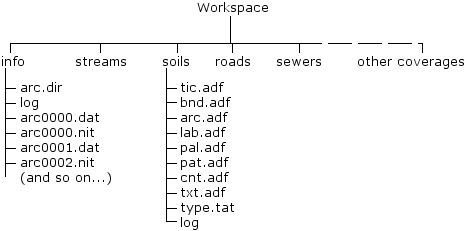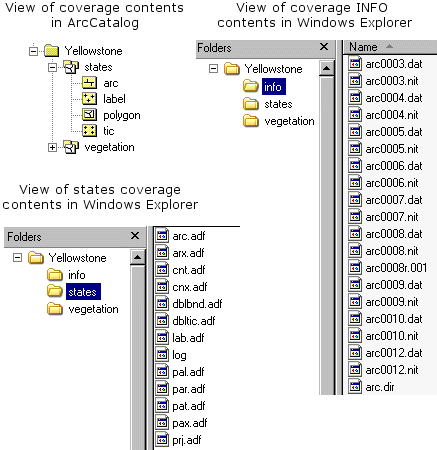A coverage is stored in the computer as a directory. The directory name is the coverage name. An organized collection of coverages is called a workspace. The following are some limitations on the coverage names:
- Cannot be longer than 13 characters
- Cannot contain spaces
- Cannot start with a number
- Does not have an extension
- Must be in all lowercase letters
A coverage is composed of a set of files, each of which contains information about a particular feature class. The set of files stored in a coverage varies depending on the feature classes present in a coverage. For example, the illustration below shows a workspace that contains a number of coverages. The directory structure and files contained in the coverage, soils, are shown below. Note that this coverage contains polygon features and an annotation subclass, type.

Each coverage workspace has an INFO database stored under a subdirectory, info. Each .adf file in a coverage folder is related to a pair of the .dat and .nit files in the INFO folder. The arc.dir file in the INFO directory is used to keep track of which pair of .nit and .dat files is related to which .adf file.
The contents of a coverage file appear differently in ArcCatalog than they do in Windows Explorer. Below you can view the contents of a coverage in ArcCatalog. The states coverage is contained in the Yellowstone workspace. The INFO folder in the workspace is not visible in ArcCatalog. The arc.adf file in the states folder is represented in ArcCatalog as the arc feature class in the states coverage.

The following table summarizes the main set of files used to store each coverage feature class. For each feature class, the common files used by ArcGIS to manage the spatial information are listed.
This is not a complete list of the files used to store a coverage. However, knowing which files are used is not as important as knowing which feature classes are present in a coverage and the geographic phenomena they represent. As a general rule, only the records in feature attribute tables are directly accessible to the user. Other files are stored in binary format and are automatically maintained by ArcGIS.
| Feature class | Spatial data in coverage directory | Feature attribute table coverage directory | Feature attribute table in INFO database |
|---|---|---|---|
Point | lab.adf | pat.adf | .nit and .dat |
Arc | arc.adf | aat.adf | .nit and .dat |
Node | arc.nit, arc.adf | nat.adf | .nit and .dat |
Route | arc.adf, sec.adf | <route>.rat | .nit and .dat |
Section | arc.adf | <route>.sec | .nit and .dat |
Polygon | pal.adf, cnt.adf, lab.adf, arc.adf | pat.adf | .nit and .dat |
Region | rxp.adf, <region>.pal | <region>.pat | .nit and .dat |
Annotation | <anno>.txt | <anno>.tat | .nit and .dat |
Tic | tic.adf | tic.adf | .nit and .dat |
Link | lnk.adf | lnk.adf | .nit and .dat |
Coverage extent | bnd.adf | bnd.adf | .nit and .dat |
Note that text in angle brackets (<>) refers to user-assigned names for the coverage or feature class. Use your operating system command for listing coverage file names.